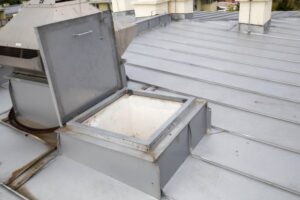Whether you’re planning on building a new commercial structure or need to access the roof of your current one, roof access hatches Adelaide are a must. Read on to learn more about the benefits of these useful doors!
The size of the hatch you choose will depend on your building’s needs. For example, a large manufacturing facility might require a ladder to reach the roof, while an office building might incorporate a staircase into the structure’s upper level.
Convenience
 Access to a roof is essential for many building uses, including maintenance and equipment installation. The convenience of a roof hatch helps meet this need by providing convenient access to a rooftop area.
Access to a roof is essential for many building uses, including maintenance and equipment installation. The convenience of a roof hatch helps meet this need by providing convenient access to a rooftop area.
Hatches can be fabricated in various sizes and shapes to accommodate specific requirements. They are most commonly used on flat roofs but can also be adapted for pitched assemblies.
Aside from offering a convenient and accessible means of accessing a rooftop, roof hatches are also designed to provide safety. It is particularly important if workers carry tools and equipment up the ladder.
For this reason, choosing a roof hatch that features safety measures such as guardrail and netting is crucial. These systems help prevent employees from falling and are OSHA-compliant.
Another common feature is hold-open arms. These arms secure the cover in an open position, preventing wind from moving or closing the hatch cover, which can be dangerous.
Other safety measures include lift assistance and a locking bar that locks the lid in an open or closed position. The lock bar is easy to operate, allowing maintenance staff to quickly open or close the hatch without needing to use a tool.
In addition to safety features, roof hatches are typically energy efficient. They provide adequate insulation to keep temperatures warm in winter and cool in summer and feature a gasket that seals the top of the curb against the underside of the cover, thereby preventing water from infiltrating.
These hatches are often made of galvanized steel or a mix of aluminium and steel. These materials are a great choice for budget-minded customers because they are inexpensive to install and maintain, require minimal cleaning, and offer basic corrosion resistance.
Stainless steel and copper products are also available, which can be useful for special applications or when additional durability is required. They can be a little more expensive than galvanized steel but still a great value. These materials are also highly resistant to corrosion and are recommended for coastal areas.
Safety
Roof access hatches are an effective way for commercial buildings to keep their rooftops safe. They help people climb the rooftop of a building and perform maintenance and repairs on equipment such as HVAC systems, air conditioning units, and water treatment systems without risking injury or damage to the property.
However, these access hatches are not immune from hazards, and many accidents can occur when they are left open. According to OSHA, falling hazards remain the leading cause of workplace fatalities, and these openings on roofs can pose a serious fall hazard.
To mitigate the danger, OSHA has strict safety regulations that require workers to safely access the roof of a building through a hatch or ladderway. Hatches should be designed with guardrails to protect users from falls, and ladderways must have railings installed near the roof edge for balance and grip.
OSHA also requires that holes in the roof be covered to reduce the risk of a worker falling into a hole. In addition, the material used to cover these holes must be durable enough to withstand twice the maximum intended load.
Moreover, the material used to cover these holes should resist corrosion. Stainless steel and aluminium hatches offer the best protection from harsh environments.
Additionally, these materials can offer insulation and energy efficiency, reducing the need for additional heating and cooling systems. They are also more affordable and easy to install.
These products are available in different sizes and are made from various materials, allowing them to suit the needs of a particular facility. Some common materials include aluminium, copper, and stainless steel.
The hatch size will depend on the type of work needed and the frequency of use. If a person needs to get on and off the rooftop frequently, a smaller hatch may be more convenient for the job. A larger model with a ship or service stair can be specified if a hatch is used to transport large pieces of equipment.
Durability
If you’re looking for a way to provide safe, convenient access to your roof without installing an expensive ladder system, you should consider installing a roof access hatch. They can offer convenience and safety to people working on your roof and prevent burglars from getting into the building.
Many kinds of roof access hatches are available in the market, and you should take the time to identify the one that’s right for your needs. First, you should decide whether the hatch will be used primarily for personnel or equipment access.
You also need to choose the size of the hatch and its built material. The latter is important because it can affect how the hatch functions, ranging from its weight to its ability to hold up against the elements.
If you want to ensure that your workers can get on the roof without risking their lives, you can install a roof access hatch with a counterbalance system and an automatic hold-open arm. It helps keep the cover open in a 70-degree position for easier operation and reduces the risk of injury from falling or tripping over the edge of the hatch.






Comments are closed, but trackbacks and pingbacks are open.